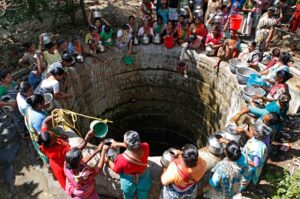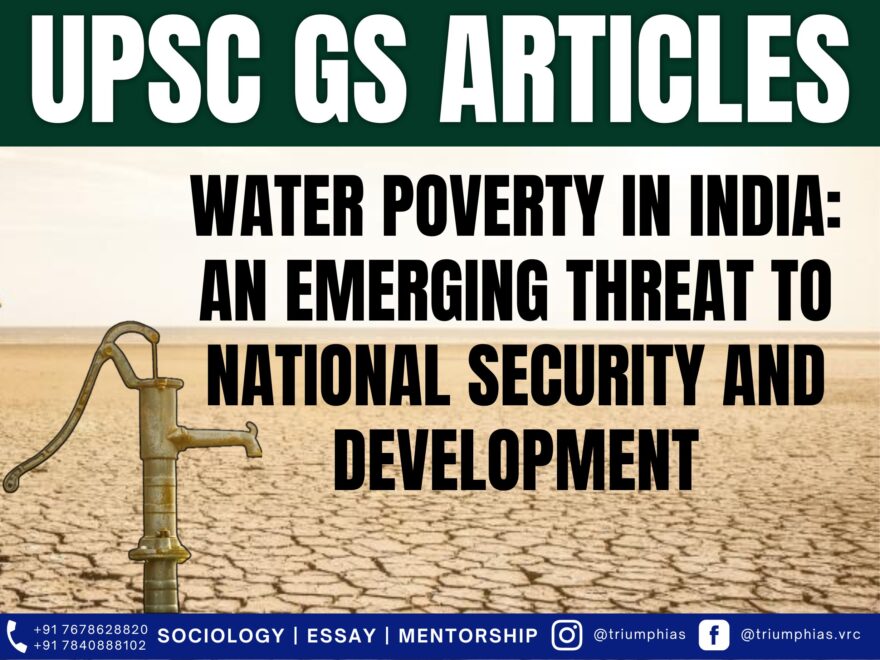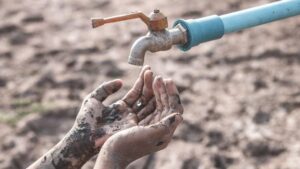Water Poverty in India
(Relevant for General Studies Paper Prelims/Mains)

Water poverty: an emerging threat for India
As per information provided by the India Meteorological Department, the South-West monsoon from June to August 2023 has witnessed subpar performance in 42% of the districts. In the month of August specifically, rainfall across the nation was 32% below the expected average, and in the southern States, this deficit escalated to 62%. Remarkably, August of this year marked the lowest recorded rainfall in India in the past 122 years, dating back to 1901.
With just around one month remaining until the conclusion of the South-West monsoon season, this decline in rainfall will not only significantly impact agriculture but also has the potential to trigger substantial water shortages in various regions of the country.
Data about water security
|
Primary Reasons behind Water Scarcity in India
- Irregular Rainfall Distribution: India faces disparities in its rainfall distribution, with the monsoon season (June to September) being the primary period for precipitation. Some states like Kerala and Meghalaya receive copious rainfall, while arid regions such as Rajasthan and Gujarat contend with persistent water shortages.
- As of September 1, 2023, the cumulative rainfall was 11% below the long-term average.
- Over-Extraction of Groundwater: Excessive extraction of groundwater for agricultural, industrial, and domestic purposes has resulted in the depletion of aquifers. The Central Ground Water Board reported that India is depleting its groundwater resources at an alarming rate, particularly in states like Punjab, Haryana, and Tamil Nadu.
- A report from June 2022 indicated that Punjab’s groundwater within the first 100 meters would be exhausted by 2029.
- Inefficient Water Management: Ineffectual water management practices, including wastage in irrigation systems, absence of water storage infrastructure, and inadequate maintenance of water sources, contribute significantly to water scarcity. According to the World Bank, India loses over 50% of its irrigation water due to inefficiencies.
- Swift Urbanization and Industrialization: Urbanization and industrial expansion have heightened water demands in cities and industrial centers. The NITI Aayog’s Composite Water Management Index (CWMI) has underscored that many Indian cities face water scarcity due to surging populations and urban sprawl.
- Water Source Contamination: Contamination of rivers, lakes, and groundwater sources compounds water scarcity issues. Water pollution adversely affects both water quality and quantity for human consumption and ecological purposes.
- The Central Pollution Control Board reported substantial pollution in major Indian rivers like the Ganges and Yamuna, negatively impacting water availability.
- Climate Change: The altering weather patterns and rising temperatures brought about by climate change have profound implications for water resources. Unpredictable monsoons, prolonged droughts, and shifts in precipitation patterns have disrupted water availability across various regions.
- El Nino, linked to global warming and often leading to reduced rainfall in India, has increasingly become a recurring phenomenon.
- Inefficient Agricultural Water Use: Agriculture, consuming approximately 85% of India’s total water resources, employs mostly outdated and wasteful irrigation techniques, resulting in low water efficiency and significant losses. Additionally, water-intensive crops like sugarcane, cotton, and paddy are cultivated in areas experiencing declining water tables.
- Government policies offering minimum support prices (MSP) and electricity subsidies for these crops encourage excessive water usage.
- Insufficient Water Infrastructure: Inadequate investments in water infrastructure, including storage reservoirs, canals, and treatment facilities, limit the capacity to manage and distribute water effectively.
- Population Growth: India, the world’s most populous nation with roughly 1.4 billion inhabitants, is projected to reach 1.7 billion by 2050. This places substantial pressure on the already limited water resources in the country.
- Lack of Effective Policy Implementation: Weak enforcement of water conservation measures, groundwater regulations, and environmental laws impedes efforts to combat water scarcity effectively.
Effects of Water Scarcity in India
- Health Challenges: Insufficient access to clean drinking water can give rise to various health issues, including dehydration, infections, diseases, and, in severe cases, fatalities. According to a report by the NITI Aayog, India witnesses approximately 200,000 deaths annually due to inadequate water supply.
- The World Bank has noted that while India comprises 18% of the global population, its water resources can sustain only 4% of its people. In 2023, an estimated 91 million Indians will lack access to safe water.
- Ecosystem Disruption: Water scarcity poses a significant threat to India’s wildlife and natural habitats. Many wild animals are forced to venture into human settlements in search of water, leading to conflicts and endangerment. Additionally, water scarcity disrupts ecosystems, negatively impacting biodiversity and ecological equilibrium.
- Diminished Agricultural Output: Water scarcity can adversely affect India’s agricultural sector, which consumes 85% of the nation’s water resources. Reduced water availability can result in lower crop yields, jeopardize food security, and exacerbate poverty among farmers.
- Economic Setbacks: Water scarcity can impede India’s economic growth and development. It can disrupt industrial production, diminish energy generation, and elevate the costs associated with water supply and treatment. Moreover, water scarcity can have adverse effects on tourism, trade, and social well-being.
- The World Bank’s 2016 report titled ‘Climate Change, Water, and Economy’ emphasizes that countries facing water shortages may experience substantial setbacks in economic growth by 2050.
Ways to address to water scarcity
- Addressing Overconsumption: One of the primary contributors to water scarcity is the excessive and inefficient utilization of water across various sectors, including agriculture, industry, and households. Embracing modern technologies like the Internet of Things (IoT), artificial intelligence (AI), and remote sensing allows for more effective measurement and management of water consumption. For instance, remote sensing and satellite monitoring can aid farmers in devising irrigation strategies based on weather conditions and local topography, ultimately conserving water and bolstering crop productivity. An illustration of this is Prashant Maroo, a Chhattisgarh farmer who harnessed IoT on his farm, resulting in a 20% boost in crop yield and reduced water usage. Additionally, reforming India’s electricity subsidy policies is imperative.
- Enhancing Water Efficiency: Another avenue to tackle water scarcity involves optimizing the performance of water systems and infrastructure, including distribution networks, treatment facilities, and storage systems. This can be achieved by repairing leaks, minimizing losses, and upgrading equipment, leading to reduced water wastage and improved water quality. For instance, UNICEF has undertaken initiatives in numerous countries, rehabilitating urban water distribution networks and treatment systems to curtail water leakage and contamination.
- Diversifying Water Sources: Exploring alternative or supplementary water sources, such as rainwater harvesting, aqueducts, desalination, water recycling, and groundwater extraction, can augment water availability and accessibility across various regions and for various purposes. Desalination, for instance, has the capability to convert seawater into freshwater, serving as a vital resource for drinking and irrigation in coastal areas.
- Preserving Water Resources: Safeguarding and rejuvenating the natural environments that furnish and regulate water, such as rivers, lakes, wetlands, forests, and soils, is paramount. These ecosystems play a pivotal role in upholding the water cycle, filtering contaminants, averting erosion, and mitigating both floods and droughts. For instance, the restoration of wetlands can significantly enhance water quality and quantity by retaining runoff and replenishing groundwater.
- Reforming Water Policies: An essential step involves revamping the policies and institutions responsible for water management and allocation. This encompasses establishing transparent guidelines and incentives for water usage, pricing, and conservation; fostering stakeholder engagement and collaboration; strengthening monitoring and enforcement mechanisms; and integrating water concerns into broader development plans.
Ensuring water security is must for inclusive growth for India .proper utilization of resources accompanied with traditional methods of water conservation can ensure security of water.
Sample Question for UPSC Sociology Optional Paper:
-
Question: What are the primary causes behind the increasing water scarcity in India?
Answer: Irregular rainfall distribution, over-extraction of groundwater, and inefficient water management are primary causes. - Question: How does water scarcity impact public health in India?
Answer: Water scarcity can lead to dehydration, infections, and diseases, contributing to approximately 200,000 deaths annually due to inadequate water supply. - Question: What role does policy play in addressing water scarcity in India?
Answer: Policy plays a critical role in setting guidelines for water usage, pricing, and conservation, and can either impede or facilitate efforts to combat water scarcity. - Question: How does agriculture contribute to water scarcity in India?
Answer: Agriculture consumes about 85% of India’s water resources, often employing inefficient and wasteful irrigation techniques, thereby contributing to water scarcity. -
Question: What is the relationship between climate change and water scarcity in India?
Answer: Climate change affects weather patterns and temperatures, leading to unpredictable monsoons and prolonged droughts, which exacerbate water scarcity issues.
To master these intricacies and fare well in the Sociology Optional Syllabus, aspiring sociologists might benefit from guidance by the Best Sociology Optional Teacher and participation in the Best Sociology Optional Coaching. These avenues provide comprehensive assistance, ensuring a solid understanding of sociology’s diverse methodologies and techniques.
water poverty in india, water poverty index in india, what is water poverty, why is there poverty in india, clean water problems in india, water scarcity in india states, water scarcity in india solutions, water poverty facts, Water Scarcity, Water Poverty, India, Monsoons, Groundwater, Urbanization, Agriculture, Health, Climate Change, Policy, Water Management, Water Crisis, Sustainability, Irrigation

Why Vikash Ranjan’s Classes for Sociology?
Proper guidance and assistance are required to learn the skill of interlinking current happenings with the conventional topics. VIKASH RANJAN SIR at TRIUMPH IAS guides students according to the Recent Trends of UPSC, making him the Best Sociology Teacher for Sociology Optional UPSC.
At Triumph IAS, the Best Sociology Optional Coaching platform, we not only provide the best study material and applied classes for Sociology for IAS but also conduct regular assignments and class tests to assess candidates’ writing skills and understanding of the subject.
Choose The Best Sociology Optional Teacher for IAS Preparation?
At the beginning of the journey for Civil Services Examination preparation, many students face a pivotal decision – selecting their optional subject. Questions such as “which optional subject is the best?” and “which optional subject is the most scoring?” frequently come to mind. Choosing the right optional subject, like choosing the best sociology optional teacher, is a subjective yet vital step that requires a thoughtful decision based on facts. A misstep in this crucial decision can indeed prove disastrous.
Ever since the exam pattern was revamped in 2013, the UPSC has eliminated the need for a second optional subject. Now, candidates have to choose only one optional subject for the UPSC Mains, which has two papers of 250 marks each. One of the compelling choices for many has been the sociology optional. However, it’s strongly advised to decide on your optional subject for mains well ahead of time to get sufficient time to complete the syllabus. After all, most students score similarly in General Studies Papers; it’s the score in the optional subject & essay that contributes significantly to the final selection.
“A sound strategy does not rely solely on the popular
Opinion of toppers or famous YouTubers cum teachers.”
It requires understanding one’s ability, interest, and the relevance of the subject, not just for the exam but also for life in general. Hence, when selecting the best sociology teacher, one must consider the usefulness of sociology optional coaching in General Studies, Essay, and Personality Test.
The choice of the optional subject should be based on objective criteria, such as the nature, scope, and size of the syllabus, uniformity and stability in the question pattern, relevance of the syllabic content in daily life in society, and the availability of study material and guidance. For example, choosing the best sociology optional coaching can ensure access to top-quality study materials and experienced teachers. Always remember, the approach of the UPSC optional subject differs from your academic studies of subjects. Therefore, before settling for sociology optional, you need to analyze the syllabus, previous years’ pattern, subject requirements (be it ideal, visionary, numerical, conceptual theoretical), and your comfort level with the subject.
This decision marks a critical point in your UPSC – CSE journey, potentially determining your success in a career in IAS/Civil Services. Therefore, it’s crucial to choose wisely, whether it’s the optional subject or the best sociology optional teacher. Always base your decision on accurate facts, and never let your emotional biases guide your choices. After all, the search for the best sociology optional coaching is about finding the perfect fit for your unique academic needs and aspirations.
To master these intricacies and fare well in the Sociology Optional Syllabus, aspiring sociologists might benefit from guidance by the Best Sociology Optional Teacher and participation in the Best Sociology Optional Coaching. These avenues provide comprehensive assistance, ensuring a solid understanding of sociology’s diverse methodologies and techniques. Sociology, Social theory, Best Sociology Optional Teacher, Best Sociology Optional Coaching, Sociology Optional Syllabus.
Best Sociology Optional Teacher, Sociology Syllabus, Sociology Optional, Sociology Optional Coaching, Best Sociology Optional Coaching, Best Sociology Teacher, Sociology Course, Sociology Teacher, Sociology Foundation, Sociology Foundation Course, Sociology Optional UPSC, Sociology for IAS,
Follow us :
🔎 https://www.instagram.com/triumphias
🔎https://www.youtube.com/c/TriumphIAS
https://t.me/VikashRanjanSociology
Find More Blogs
|
Scope of the subject and comparison with other social sciences |
|||
|
|
|
|
Modernity and social changes in Europe |


